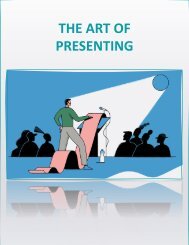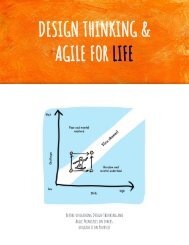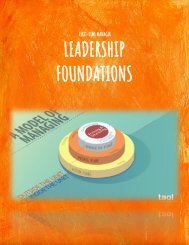2020 iLEAD e-book
- No tags were found...
Create successful ePaper yourself
Turn your PDF publications into a flip-book with our unique Google optimized e-Paper software.
How to use R in SCAMPER<br />
TWITTER SUMMARY<br />
Reversing your perspective or rearranging what you know in order opens your mind and lets you see things<br />
you’d normally miss.<br />
KEY IDEA<br />
Creativity consists largely of rearranging what we know in order to find out what we don’t. Can you rearrange<br />
something?<br />
<br />
<br />
<br />
<br />
<br />
<br />
<br />
<br />
<br />
<br />
<br />
<br />
<br />
<br />
<br />
<br />
<br />
How else can this subject be arranged?<br />
What other arrangement might be better?<br />
What would happen if you interchanged components?<br />
Can you change the order? Where should this be in relation to that?<br />
What other layout might be better? Other pattern?<br />
Can you draw your subject? Diagram it? Chart it?<br />
Can you change the sequence? What should come after what?<br />
How about timing? Can you change the pace? The schedule?<br />
Set a different tempo? Set a deadline?<br />
What if you transpose cause and effect? What might be altered?<br />
Counteracted?<br />
What if you switch the verb and the object in your original statement?<br />
So, for example, “how can we sell more bottles?” becomes<br />
“How can we bottle more sales?”<br />
Do you get a different perspective?<br />
What if you rearranged the way you work on this problem?<br />
Can you rearrange your environment? Priorities? People? Habits?<br />
Reversing your perspective opens your mind and lets you see things you’d normally miss. Ask “What is the<br />
opposite of this?” to find a new way of looking at things. Creative geniuses throughout history have gotten<br />
their most original ideas by reversing aspects of their subjects.<br />
<br />
<br />
<br />
<br />
<br />
<br />
<br />
<br />
<br />
<br />
<br />
<br />
<br />
<br />
<br />
<br />
<br />
What are the opposites? What happens when they are reversed?<br />
Can you transpose the positives and negatives?<br />
Can you reverse the way you look at your subject?<br />
Why not turn it around? Up instead of down? Down instead of up?<br />
Play devil’s advocate with it? What if you reversed relationships?<br />
Uses? Functions? Goals? Ideas? Roles?<br />
Can you list three assumptions you are making about this subject?<br />
What happens when you reverse them?<br />
Can you figure out how to make the reversals work?<br />
What are the negatives? Can you reframe them into positives?<br />
Can you visualize your desired result?<br />
Can you work backwards from that result to your subject?<br />
Does working backwards help you figure out how to make the result possible?<br />
Can you imagine yourself as a member of the opposite sex?<br />
How would that change your perception of the problem?<br />
Would you have different values? Different insights?<br />
Can you think of an idea about your subject that you’ve dismissed as useless?

















